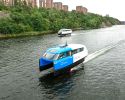Virtual wires can improve safety and reduce staff shortages

Can a digital wire replace physical steering cables on ferries? Absolutely! In Finland, a concept has already been developed, and a Swedish study funded by the Swedish Transport Administration shows that a similar system adapted to Swedish conditions could offer several advantages.
In Finland, motorized cable ferries are common, where the cables are only used to keep the vessel on its route, not for propulsion. Therefore, it is not surprising that Finland has developed and is already using a concept where the physical steering cable has been replaced with a virtual wire. The concept, which aims to support the operator, has several advantages, explains Ted Sjöblom, research and development engineer at RISE.
"Above all, it is much safer. A conventional steering cable is tensioned both in front of and behind the vessel, increasing the risk of collisions with it. Additionally, it can stir up bottom sediments, is unusable in icy conditions, and is limited to routes with straight paths and docking locations."
In Sweden, pull cables are used—except in two cases: the ferries on the Isöleden route in Jämtland and the ferry between Koön and Marstrand, which use a steering cable without propulsion assistance. Still, a concept building on the Finnish model could be relevant for Sweden.
"With a virtual steering line, the ferry can be operated by personnel with lower certification requirements. A major driving force behind the study is the challenge of recruiting qualified ferry personnel, a trend expected to worsen in the future. A broader recruitment base could enable expanded service offerings, such as more frequent departures," says Ted Sjöblom.
The idea for a Swedish variant is that it would primarily be used for free-moving ferries—since the route of a virtual wire does not have to be straight. In a feasibility study funded by the Swedish Transport Administration, RISE has therefore explored the possibilities of a concept based on advanced automation technology inspired by autonomous ferries. The system combines features such as automatic docking, departure, and decision support to handle various traffic situations. By integrating the control system with situational decision support, the operator gains a clearer and more convenient overview.
"The operator controls the vessel, but in complex situations where careful decision-making is required, the system can take over and maintain the vessel’s position."
As part of the project, a successful demonstration was carried out on Riddarfjärden with the ferry Estelle in collaboration with Zeabuz. The tests showed that the digital system can maintain the simplicity and reliability of traditional cable ferries while offering more flexible and energy-efficient operation.
"By consistently repeating optimized navigation patterns, energy efficiency can be improved. Additionally, new routes can be established with minimal environmental impact, without the need to rebuild docking locations," says Ted Sjöblom.
Despite the positive results, several challenges remain before virtual wires can be implemented on a larger scale. The project concludes that while virtual wire systems have potential, extensive testing and evaluation in a Swedish context are necessary. Factors such as operator training, system maintenance, regulations, infrastructure integration, and public perception must be considered to ensure a successful implementation, the researchers write in their final report.
The report, Virtual Wires as a Safety-Enhancing Concept, was authored by Ted Sjöblom, Rick Olsson, Carl Petersson, Roshni Pramanik, Martin Sanfridson, Fredrik Olsson, Joakim Lundman, Mattias Wallin, Thomas Elwinger, Fredrik Almlöv, Fredrik Skeppstedt, Susanne Stegberg, and Håkan Burden.
-
 NextWave – en podd som ska locka unga
NextWave – en podd som ska locka unga -
 Ny studie: Eldrivna pendelbåtar kan effektivisera Stockholms kollektivtrafik
Ny studie: Eldrivna pendelbåtar kan effektivisera Stockholms kollektivtrafik -
 Sjöfartens utsläpp ökar
Sjöfartens utsläpp ökar -
 Sociala relationer påverkar val av bränsle
Sociala relationer påverkar val av bränsle -
 Sjöfartens omställning kräver ”mjukare” påtryckningar
Sjöfartens omställning kräver ”mjukare” påtryckningar -
 Hon hade avtalad tid med Kapten ynkrygg
Hon hade avtalad tid med Kapten ynkrygg -
 Lighthouse omvärldsanalys 2025 – osäkerhet och tullar präglar sjöfarten
Lighthouse omvärldsanalys 2025 – osäkerhet och tullar präglar sjöfarten -
 Se seminariet Shipping in the Marine Environment
Se seminariet Shipping in the Marine Environment -
 Vad betyder egentligen de 90 procenten?
Vad betyder egentligen de 90 procenten? -
 Hålla där...
Hålla där...

